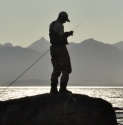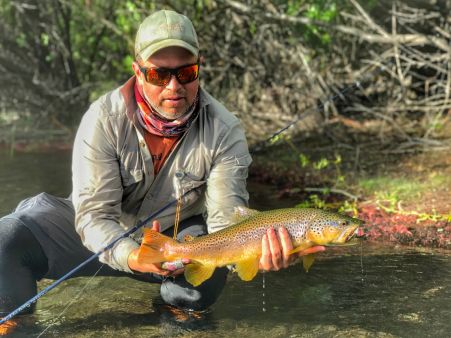What is Whirling Disease?
The whirling disease parasite, Myxobolus cerebralis, is native to Europe and was first described in Germany in 1903.
Whirling disease is the descriptive side effect produced by a complex relationship involving a non-native parasite and a common aquatic worm that exclusively impacts coldwater sportfish, specifically trout and salmon. The parasite becomes engulfed by a tubifex worm, which acts as an intermediate host for the parasite. Eventually, this relationship produces a new free-floating life phase of the parasite that attaches itself to trout and salmon. After coming into contact with the host fish, the parasite penetrates the head and spinal cartilage of fingerling trout where it multiplies very rapidly, putting pressure on the organ of equilibrium. This causes the fish to swim erratically (whirl) and have difficulty feeding and avoiding predators. It is this whirling effect that has provided the name for disease that has significantly impacted our coldwater fishery resources.
Which are the symptoms?
Physical symptoms of whirling disease include blackened tail, whirling behavior, and deformities of the head and spine.
How does it spread?
Infected fish and fish parts are the primary vector for transmitting whirling disease. It may also be transmitted by birds and it is possible fishermen could carry the disease on fishing equipment. However, live infected fish are the main vector for the spread of the disease.
Where Whirling Disease is currently found?
The parasite is now distributed on nearly every continent. It was introduced into North American waters in the late 1950s. Currently, it is found in 22 states including: Alabama, California, Colorado, Connecticut, Idaho, Maryland, Massachusetts, Michigan, Montana, Nevada, New Hampshire, New Jersey, New Mexico, New York, Ohio, Oregon, Pennsylvania, Utah, Virginia, Washington, West Virginia and Wyoming, in several European countries, South Africa, and in New Zealand.
How can anglers help to prevent the spread of this disease?
Anglers are most impacted by whirling disease because it affects the health of one of the most popular fish sought by anglers. Stocking or natural movement of live, infected fish is the primary route by which whirling disease is disseminated. However, the parasite can also be spread by humans and particularly anglers. To prevent the spread of whirling disease to additional populations of trout and salmon, anglers must adapt the prevention procedures listed below.
Anglers, boaters and others can make a difference in reducing the chances of spreading whirling disease. Distribution of the parasite is expanding rapidly in many areas, so it is recommended to take some precautions to help prevent the spread of whirling disease.
1. Never transport live fish from one water body to another.
2. Do not use trout, whitefish, or salmon parts as cut bait.
3. Dispose of fish entrails and skeletal parts properly.
- Never discard fish parts in or near streams or rivers, simply disposing of infected fish parts in a clean drainage could provide enough spores to start an infection.
- Do not discard fish parts in a kitchen disposal. Whirling disease myxospores can survive most wastewater treatment systems. Instead, discard in dry waste that would go to a landfill.
5. Although the above precautions will remove most spores from your gear, consider the following if fishing in heavily infected waters:
- Rinse and thoroughly dry your boots, waders and other fishing equipment.
- Chlorine
(regular household bleach) is a very effective disinfectant, and one of
the few that can kill all stages of the parasite if used at the proper
concentration. However, as it is a very strong chemical that can damage
your equipment, make sure you rinse the chlorine off your waders and
other equipment after you disinfect, and dry in the shade.
- To kill the TAM stage, use 1 part chlorine to 32 parts water. It must stay in contact for about 10 seconds to assure disinfection.
- To
kill the mature myxospore that may be found in the mud from an infected
stream is much more difficult and hard on equipment.
- 50% solution (1 part chlorine to 1 part water) - dip waders into a solution of the bleach or wipe or spray on.
- 10% solution (1 part chlorine to 9 parts water) and soak your equipment for 10 minutes.
- Quaternary ammonium compounds are also effective in killing both parasite stages.
- Equally effective is water heated to nearly boiling (200 degrees F) poured over your gear and allowed to cool.
- Whirling Disease Initiative, Montana Water Center, Montana State University. (http://whirlingdisease.montana.edu/).
- Whirling Disease Foundation (www.whirling-disease.com).
- The National Invasive Species Information Center (NISIC), United States Department of Agriculture. (http://www.invasivespeciesinfo.gov).
- The Global Invasive Species Database. (http://www.issg.org).
- Wikipedia. Whirling Disease.








